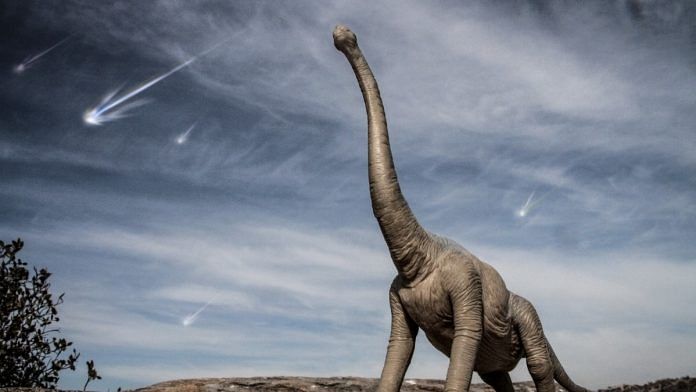Dinosaur fossils from Argentina point to the largest animal ever on record
Scientists have discovered fossils dating back 98 million years ago that belonged to a dinosaur that was possibly the largest animal to walk planet Earth.
The remains of a long-necked titanosaur dinosaur was first discovered in Argentina in 2012, but have still not been fully excavated.
The bones that have been unearthed so far suggest the dinosaur is possibly the largest one on record. Titanosaurs were among the largest sauropods — long-necked, plant-eating giant dinos — and lived from the late Jurassic period (163.5 million to 145 million years ago) to the end of the Cretaceous period (145 million to 66 million years ago).
The researchers are yet to fully analyse the remains and they do not have enough evidence yet to declare this dinosaur as a new species. More on Smithsonian Magazine.
How some male mantises escape being eaten after sex
Scientists fixed up sparring matches between mantises to understand how certain males escape cannibalism after mating.
Female mantises usually eat their male counterparts before or after mating. However, some male springbok mantises sometimes escape cannibalism by wrestling and injuring the female during mating bouts.
In the study, researchers found that males springboks that managed to pin down the female were more likely to mate and survive the encounter. In contrast, female mantises that won the wrestling match always cannibalised the male, the researchers found.
Cannibalism in springbok mantises almost always happens before mating, which gives the females a bounty of nutrients helpful in reproduction. Female springbok mantises can produce offspring asexually from unfertilised eggs in a process known as parthenogenesis.
To understand how male mantises pass on genes when females are so determined to eat them, the team caught 104 mantises from local gardens and parks. Then they divided them into 52 male-female pairs and observed them in a lab.
Of the 52 pairs, 29 (56 per cent) of the males initiated contact with the female during the first 12 hours. Of these 29 contacts, 26 (90 per cent) escalated to violent struggles. The females won more than one-third of these 26 wrestling matches, pinning down and cannibalising the males in nine (35 per cent) of the cases.
Meanwhile, males succeeded in pinning down females in 15 (58 per cent) of the struggles, and of those, 67 per cent mated (half of which were cannibalised), 13 per cent were cannibalised without mating and 20 per cent didn’t mate or get cannibalised. More on Livescience.
Also read: Gene-editing cures progeria in mice — a fatal condition Amitabh Bachchan portrayed in ‘Paa’
Research suggests black holes may grow to sizes larger than earlier thought
A new study suggests that the universe possibly hosts “stupendously large black holes” or SLABS, which are even larger than the supermassive black holes (SMBHs) already observed in the centers of galaxies.
The research investigated how these SLABs could form and how big they can get.
While there are plenty of examples of SMBHs, existing understanding of black holes suggest that they can’t grow beyond a certain size. However, the existence of SLABS could provide researchers with a powerful tool for cosmological tests and improve our understanding of the early universe.
It has widely been thought that SMBHs form within a host galaxy and grow to their large sizes by swallowing stars and gas from their surroundings or merging with other black holes. In this case, there is an upper limit on their mass — somewhat above ten billion solar masses.
In this study, the researchers propose another possibility for how SMBHs could form, which might evade this limit. They suggest that such SLABs could be ‘primordial’, forming in the early universe, and well before galaxies.
As ‘primordial’ black holes don’t form from a collapsing star, they could have a wide range of masses, including very small and stupendously large ones. More on Space Daily.
Climate change will shift the position of the tropical rain belt
The tropical rain belt — a narrow band of the Earth near the equator that receives heavy precipitation — is likely to shift due to climate change, threatening food security for billions of people, a new study suggested.
Researchers stressed that not all parts of the tropics will be affected equally. For instance, the rain belt will move north in parts of the eastern hemisphere but will move south in areas in the western hemisphere.
According to the study, a northward shift of the tropical rain belt over the eastern Africa and the Indian Ocean will result in future increases of drought stress in southeastern Africa and Madagascar, in addition to intensified flooding in southern India.
The change will cause the position of Earth’s tropical rain belt to move in opposite directions in two longitudinal sectors that cover almost two thirds of the globe — a process that will have cascading effects on water availability and food production around the world, according to the researchers. More on Science Alert.
Also read: For the first time ever, astronomers are witnessing a galaxy’s ‘death’ as it’s happening




Excellent periodic summary of scientific developments. Can increase the number of topics covered.
Dear author:
You write on science, yet use the words “it is widely known”. Stop using these weasel words.
You see, Science doesn’t actually discourage the use what you call “weasel words” — For example, when you asserted the last time that the earth is round, you hadn’t yourself empirically verified so. You had accepted what was “widely known”….
It is perfectly legitimate to use “weasel words”, so long as there is no attempt to be intentionally ambiguous or mislead. (This follows from the actual definition of “weasel words”)